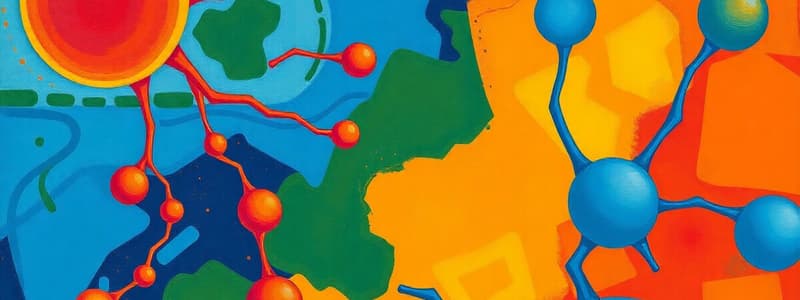Podcast
Questions and Answers
What is the primary role of positive feedback in hormonal activity?
What is the primary role of positive feedback in hormonal activity?
- It prevents excessive hormone production.
- It serves as a delay mechanism in hormone secretion.
- It reduces hormone levels to restore balance.
- It amplifies the initial stimulus and response. (correct)
Which of the following hormones is involved in the regulation of salt and water balance in freshwater fish?
Which of the following hormones is involved in the regulation of salt and water balance in freshwater fish?
- Antidiuretic hormone (ADH)
- Ecdysteroid
- Oxytocin
- Prolactin (correct)
What mechanism stimulates the secretion of hormones from endocrine glands?
What mechanism stimulates the secretion of hormones from endocrine glands?
- Changes in hormonal levels exclusively.
- Direct neural impulses only.
- External environmental factors alone.
- Blood concentrations of non-hormone chemicals. (correct)
What hormones are produced in the posterior pituitary gland?
What hormones are produced in the posterior pituitary gland?
Which of the following hormones is responsible for the growth of mammary glands and milk production in mammals?
Which of the following hormones is responsible for the growth of mammary glands and milk production in mammals?
What is the primary function of the endocrine system?
What is the primary function of the endocrine system?
Which hormones are classified as lipid soluble?
Which hormones are classified as lipid soluble?
What role does the hypothalamus play in the endocrine system?
What role does the hypothalamus play in the endocrine system?
Which of the following describes how water soluble hormones interact with target cells?
Which of the following describes how water soluble hormones interact with target cells?
What mechanism primarily controls hormone secretion in the endocrine system?
What mechanism primarily controls hormone secretion in the endocrine system?
Which gland is often referred to as the primary link between the endocrine system and the nervous system?
Which gland is often referred to as the primary link between the endocrine system and the nervous system?
What is a characteristic of polypeptide hormones?
What is a characteristic of polypeptide hormones?
Which of the following is NOT considered an endocrine gland?
Which of the following is NOT considered an endocrine gland?
Flashcards
Positive feedback
Positive feedback
A system where the product of a reaction stimulates further production of itself, amplifying the response.
Prolactin
Prolactin
This hormone is responsible for stimulating milk production in mammals.
Hormone cascade pathway
Hormone cascade pathway
A series of hormones that interact with each other, starting from the hypothalamus and ending at the target tissue. Each hormone in the pathway triggers the release of the next.
Releasing or Inhibiting hormones
Releasing or Inhibiting hormones
Signup and view all the flashcards
Posterior Pituitary
Posterior Pituitary
Signup and view all the flashcards
Hormones
Hormones
Signup and view all the flashcards
Homeostasis
Homeostasis
Signup and view all the flashcards
Endocrine glands
Endocrine glands
Signup and view all the flashcards
Exocrine glands
Exocrine glands
Signup and view all the flashcards
Feedback loop
Feedback loop
Signup and view all the flashcards
Negative feedback
Negative feedback
Signup and view all the flashcards
Pheromones
Pheromones
Signup and view all the flashcards
Study Notes
Endocrine System Overview
- The endocrine system is responsible for producing and regulating hormones.
- Hormones are chemical messengers that travel through the blood to target cells.
- Hormones trigger responses in target cells leading to a physiological response.
Signaling Molecules
- Hormones are signaling molecules.
- The word hormone comes from the Greek word "horman" meaning "to excite" or "to activate".
Types of Signaling Molecules
- Some signaling molecules act within the body, while others can act outside the body (e.g. pheromones).
Classes of Hormones
- Hormones are classified into three major chemical classes:
- Polypeptides (e.g., insulin): water-soluble
- Amines (e.g., thyroxine, epinephrine): water-soluble
- Steroids (e.g., cortisol): lipid-soluble
Hormone Action
- Water-soluble hormones cannot diffuse through plasma membranes. They bind to cell-surface receptors, influencing cytoplasmic molecules and sometimes altering gene transcription.
- Lipid-soluble hormones diffuse across the membranes. They bind to transport proteins, enter target cells, and bind to receptors within the cytoplasm or nucleus, triggering changes in gene transcription.
Hormone Effects
- Some hormones can produce more than one effect on different target cells.
- For example, epinephrine affects liver cells, blood vessel smooth muscle cells in skeletal muscle, and blood vessel smooth muscle cells in the intestines in different ways.
Hormone Production and Control:
- The endocrine system contains different structures like glands and other organs that produce hormones.
- Hormone secretion is regulated by feedback mechanisms:
- Some hormones are released in response to internal or external stimuli.
- A stimulus could be a low pH level in the duodenum.
Negative Feedback
- The response to the hormone opposes to the initial stimulus.
- Example: in secretin signaling, low pH in duodenum stimulates the release of secretin which causes a response of bicarbonate release.
Positive Feedback
- The hormone's response amplifies the initial stimulus.
- Example: suckling stimulates oxytocin release, oxytocin stimulates milk ejection, and milk ejection reinforces suckling.
Neuroendocrine
- The endocrine system and nervous systems work together to maintain homeostasis.
- The hypothalamus is a primary link between two systems using chemical messengers to stimulate or inhibit hormone secretion from the pituitary gland.
Hormone Secretion Stimulus
- Hormones are secreted in response to:
- Blood concentrations of non-hormone chemicals.
- Another hormone.
- Neural stimuli.
Evolution of Hormone Function
- Same hormones can have different functions in different organisms.
- For example, prolactin regulates milk production in mammals but regulates fat metabolism and reproduction in birds.
- Hormones produce different responses in amphibians, and freshwater fish.
Studying That Suits You
Use AI to generate personalized quizzes and flashcards to suit your learning preferences.



